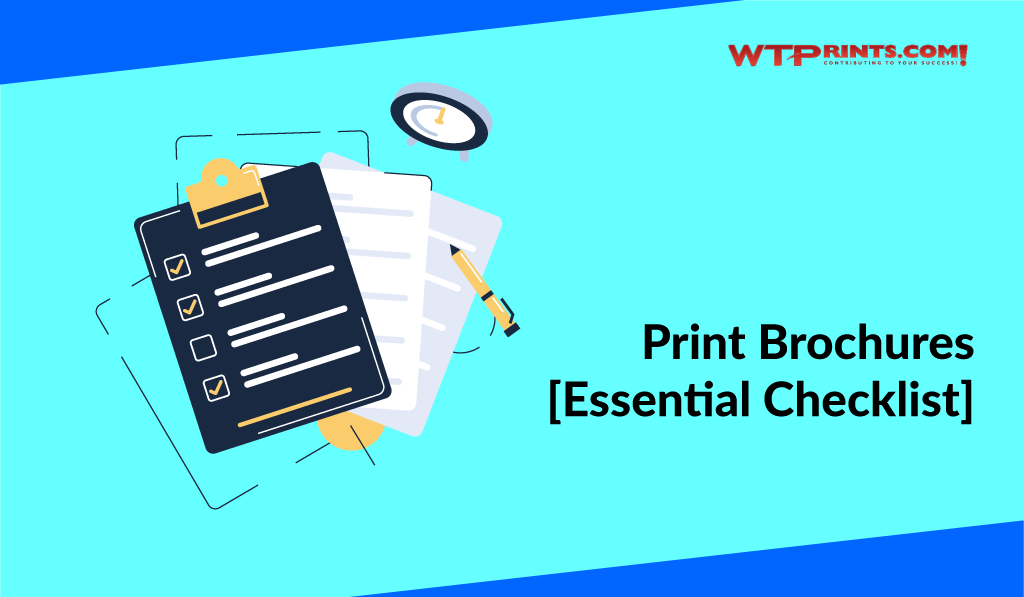In the face of endless pressure to be digital marketers, print provider clients need to be frequently reminded of the power of print. Print brochures never lost the power to capture attention and drive sales. Whether your clients are launching a new product, re-branding, or reaching out to potential clients, a well-designed brochure can be a compelling instrument.
We put together a Checklist for Brochures that covers every aspect you or your client needs to know about creating a brochure that hits the mark and gets results. It covers everything from targeting the audience, to content and visuals, through to finishing.
If you don’t already have such a checklist, you can download our print brochure checklist in PDF or Word format and easily customize it to represent your business. Or simply copy and paste the content below. (Scroll to the bottom for the links to download the PDF or Word document.)
Checklist for Print Brochures

A well-designed and printed brochure is a powerful marketing tool for any business. Here are some essential steps to follow.
❑ Know your target audience. Before you start designing your brochure, it's important to know who you're designing it for. What are their pain points? What problems are they trying to escape. What are they looking for? What kind of language and visuals resonate with them? Knowing this helps you create a brochure that speaks to their needs and interests.
❑ Write the content for your brochure. If needed, use a professional copywriter to craft compelling content.
❑ Consider adding a sales letter to go with the brochure. There’s a saying in marketing that “the letter sells, the brochure tells.” A brochure on its own is not likely to sell the appointment or the product. Unless the brochure is given to the prospect by a salesperson, a letter is typically needed to move the client to action.
❑ Choose the right size and format. The size and format of your brochure depends on your target audience, the purpose of your brochure, and how it’s going to be used. Is it for use in stores? In a direct mail marketing campaign? Or both?
You can choose from various paper sizes and formats such as bi-fold, tri-fold, map fold, z-fold or any number of gatefolds. Talk with your designer and print provider to find the best options.
❑ Create a compelling, simple design. Your brochure should be visually appealing and easy to read. Avoid clutter. Use clear, concise text and a consistent color scheme to create a professional look. Use visuals to break up text and make the brochure more visually attractive.
❑ Use high-quality images. High-quality images can make a big difference in the effectiveness of your brochure. Use professional images that are relevant to your message and high resolution for crisp printing. Avoid images taken from a website.
❑ Craft a powerful headline. The headline should grab your audience's attention and convey the main benefit of your product or service.
❑ Include a call-to-action. What do you want your readers to do after they read your brochure? Always include a clear call to action, such as visiting your website, calling for more information or a consultation, or visiting your store.
❑ Include QR codes. QR codes can give the reader access to almost limitless content. They can lead to demonstration videos, FAQs, or any relevant website page or other content.
❑ Choose the right paper. The paper you choose will affect the look and feel of your brochure. Consider the weight, texture, and finish of the paper. A glossy finish can make colors pop, while a matte finish can give a more sophisticated look.
❑ Choose the right print finishing options. Additional ways to make your brochure pop include various print finishes such as embossing, foil stamping, die cutting, Soft Feel coatings, Flood and Gloss UV coating, or our favorite – Soft Feel AQ (aqueous) with Spot Gloss UV.
❑ Proofread and edit. Before you send the brochure to your print provider, have at least two people proofread and edit your content. Check for grammar and spelling errors and make sure all information is accurate. For the most accurate proofreading results, print your brochure on paper. It is too easy to “skim” on a digital device and paper will reveal things that go unnoticed on a digital device.
❑ Choose the right print provider. Choose a reputable print provider that offers high-quality printing and folding services and can deliver your brochures on time.
❑ Prep your files for pre-press and printing. If you’re working with a print provider who is handling your design work, you won’t have to worry about this part. They’ll do it for you. Otherwise, follow your print providers file submission checklist.
By following this checklist, you can create a brochure that effectively communicates your message, grabs your audience's attention, and drives sales for your client's business or yours. Done right, your brochure will deliver results for the long term.
Download the checklist in Word here.
Download the PDF checklist here.
Be sure to check out more tips on running a printing business here.